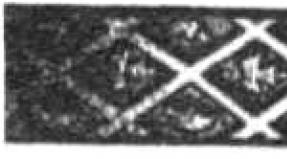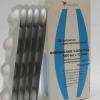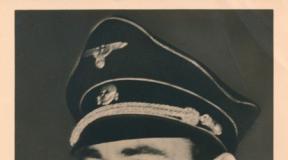Mehendi at home. Instructions for using ready-made henna (cone, tube) Secrets of drawing henna
The cones and tubes contain already fully prepared henna for mehendi - diluted to the desired consistency and already containing all the necessary additives. Ready-made henna is a great invention for those who save their time and energy. Henna comes in completely different colors, from classic natural, black, brown, to pink and green.
2. Carefully trim the cone (the thinner the tip, the finer the lines)
In the tube comes a ready-made cap with a hole. If you are using a tube, unscrew the cap, remove the protective foil and screw the cap back on.
3. Do an allergy test first. To do this, apply the finished paste on the bend of the elbow (inner part) for 20 minutes, then rinse. If no reaction is found within 2 hours, you can safely proceed to painting. The most allergenic is black henna.
4. By pressing on the cone, you squeeze out the henna. The harder the pressure, the thicker the lines. 
5. It is better to remove the dried henna paste not earlier than after 1-3 hours. Natural henna should be kept on the skin for as long as possible (from 3 to 8 hours) 

6. We remove the dried henna paste, slowly, helping ourselves with a fingernail, or an orange stick
7. Wetting the drawing should not be earlier than after 3-4 hours
Henna is of several types:
natural henna for mehendi in a cone
- natural dye, prepared on the basis of henna without chemical additives and packed in a traditional form for drawing - a cone.
- such a paste is already ready for applying decorative patterns.
- like the powder, it is absolutely natural, contains a mixture of 13 different herbs and therefore has a beneficial, regenerating effect on the skin.
- lasts long enough

Quick henna paste
in a cone and in a tube
Henna pastes, in which color changes are achieved mainly due to natural ingredients. Sold in cones and tubes
- disappear from the skin faster than classic henna mehendi.
- In rare cases, allergic reactions are possible.
- have a bright black or red color, which allows you to make colored mehendi, reminiscent of tattoos;
- leave a bright color on the skin immediately
- dry quickly - enough to hold on the skin for 20-40 minutes after application

Henna - paint of various colors for biotattoo
There are a variety of colors - orange, green, blue, pink, green, purple, blue.
- hold approximately like “quick henna” - not very long.
Pros:
- allows you to apply drawings of different colors
- easy to draw thanks to convenient tubes
- dry quickly - enough to hold on the skin for 20-40 minutes.


white henna
Henna
is a coloring matter that tends to be absorbed into the top layer of the skin.
But, white matter having such properties has not yet been invented!
In the tube, in most cases, there is glue for bio-tattoo and face painting. This beauty does not last very long (several hours), and is designed for a short-term event, but white henna looks great in the photo, as it is voluminous and bright, and of course, it immediately captivated many photographers and artists. So if you are planning a wedding photo session, believe me, you will be irresistible.

Every girl deep down dreams of decorating her body with an interesting pattern, but for many, “eternal” tattoos are too serious a step. We suggest considering how to make temporary henna tattoos, provide interesting stencils for girls, tell you about the principle of application and how long the paint lasts, as well as the price of the powder.
Mehndi or henna is a very ancient art of decorating the body of women. It was used in ancient Egypt, India, Persia and even some Slavic peoples. This technique allows you to leave elegant and cute marks on the body, leg, arm, etc., but most importantly, not forever, because the paint is applied precisely to the surface of the skin, and not under it.
Most often, biotattooing with henna, basma, or drawings with a mixture of these substances can be seen on the arms (palms, wrists), legs (feet), bikini (erotic biotattoo), back and lower back. The most desperate representatives of the beautiful half of humanity also draw patterns on the neck, chest, decorate the shoulder or hips with inscriptions.
Safety and health
Most of all, people visiting beauty salons that provide tattoo services with basma and henna are afraid of a possible allergy. It must be said that basma and henna tattoos are the most harmless pictures that can only be applied to the body. They are completely composed of natural substances that are hypoallergenic. The risk is minimized. In addition, many argue that after dyeing the hair and body with henna, the regeneration process is accelerated, this technology even allows you to treat psoriasis, alopecia and other diseases.
 The only thing that can alert you is that sometimes cosmetic oils are included in the mixture, it can be orange, lemon, grapefruit, etc. They are used to make the trace after henna darker and more contrasting. If you use low-quality oil, undiluted, or you overheat it, you can get burned. But in most cases, the reviews are encouraging.
The only thing that can alert you is that sometimes cosmetic oils are included in the mixture, it can be orange, lemon, grapefruit, etc. They are used to make the trace after henna darker and more contrasting. If you use low-quality oil, undiluted, or you overheat it, you can get burned. But in most cases, the reviews are encouraging.
This technology is used both for "tattooing" adults and for decorating children.
This paint is natural and useful for the dermis of any age, in addition, such drawings look really beautiful and stylish (especially if the ethnic style is supported by accessories and appropriate makeup).
Advantages and disadvantages:
- The skin becomes fresher and more toned, this remedy is sometimes added to nourishing masks and scrubs;
- Can be applied to any point of the body, they are completely harmless;
- It doesn’t hurt, it’s even pleasant, because the technique of applying henna can replace tactile massage, relax after a hard day, awaken sensuality in girls;
- The main disadvantage is that the pattern is washed off very quickly. They say that it lasts from 5 days to two weeks, this is not entirely true, if a person often bathes (for example, visits the pool or swims in the sea), then the tattoo will live no more than 2 days.
- The integrity of the skin is not violated, moreover, some diseases are treated;
- They don't leave a sticky residue behind like stickers.
- It’s easy to do it yourself, if you graduated from an art school, then drawing henna on the body will not be difficult.
Video: how to make temporary tattoos on the hands of henna
Making your own tattoo step by step
Let's take a closer look at how to make a henna tattoo at home, select a recipe and a sketch, and also consider drawing a picture. Important: if you are not confident in your abilities, then it is better to seek help from a person who knows how to draw, or practice on inconspicuous areas of the body, in any case, a trace of henna will “decorate” you for a while.
 Photo - Pattern stencils for tattoos
Photo - Pattern stencils for tattoos To get started you need decide on the style of the drawing. There are several options:

We offer you our selection of photos, beautiful templates and ready-made Indian sketches, according to which henna tattoos are made at home. Remember, the meaning of the tattoo will be the way you thought of it for yourself.
To make henna for a tattoo we need:
- Henna powder (one spoon will decorate the hands of six people)
- A few tablespoons of very strong tea or coffee
- Two lemons or limes
- Strainer
- Wooden or steel alloy spoon
- Ceramic, glass or wooden mixing bowl.
 Photo - Tattoo on the back
Photo - Tattoo on the back The general rule when mixing henna is that the more acid, the darker the mixture. If the paste does not give a dark enough stain, you just need to dilute more citrus juice into it, i.e. a black tattoo does not imply the addition of more basma or coffee (it will rather give an extra “brownishness”).
Step-by-step instruction:
- Use the sieve to sift the henna powder into the bowl;
- Strain the juice from one lemon or lime into a bowl of powder, stirring the mixture until a smooth paste is formed;
- Add very hot strong tea or coffee to make the mixture a little softer than toothpaste, now cover the mixture with a cloth and leave overnight until it swells;
- The shelf life of such a paste in the refrigerator is 2-5 days.
 Photo - Multi-colored tattoo
Photo - Multi-colored tattoo Secrets of drawing henna
When the mixture is ready in the morning, you need to mix it thoroughly again and proceed to outline the outline and create a tool with which we will draw. You can use dense polyethylene, foil, real "home professionals" operate even simple packages. In general, anything that does not leak and can be made into a cone will do.
- Cut out a 5cm x 5cm square from the plastic bag. Place a tablespoon of henna paste in the center of the square. Henna should be the consistency of toothpaste;
- Fold one side over the other to make a cone shape;
- Roll the tip of the cone between your thumb and forefinger until the hole at the tip of the cone is the diameter of a sewing needle;
- Secure the sides of the cone with tape. When you squeeze the tape, paste will come out of the cone nose;
- Use the cone the same way you would with a cake decorator to make fine lines by gently squeezing the tip.
 Photo - Henna drawing
Photo - Henna drawing Important! Before applying, you need to lubricate the dermis with oil, you should not forget about this, by the way, often a set of cosmetic oils contains wooden sticks for aromatization. Their wide ends are also a great coloring tool.
The average cost of a henna tattoo-inscription in Russia, Belarus and Ukraine is 2-3 dollars, but it is clear that it will be cheaper to make a drawing with your own hands.
You can order henna directly from India or use powder from domestic stores. You should beware of very cheap mixtures, they can be harmful to delicate skin. Also, many stores have ready-made compositions of all colors, just ask the seller for a catalog of tattoo inks, you can also buy other materials and tools there.
The night before:
Before starting kneading, it is advisable to sift henna through small sieve. This is a necessary requirement if your drawing will have a lot of thin lines and you are going to draw with a syringe. Thin lines are successfully drawn only with a homogeneous paste of well-sifted henna. Or wipe the finished mixture through a strainer.
About in 24 hours before the intended use of the paste, pour 20 grams henna(1 heaping tablespoon) to a glass bowl and add 1/4 cup lemon juice. Stir the henna with lemon juice until smooth so that there are no lumps left in the mixture. At this stage, the consistency of the mixture is thick, reminiscent of mashed potatoes. Wrap the formula container in a plastic bag, seal tightly to restrict air entry, and leave for at least at 12 o'clock in a warm place (22 - 25°C). You can slightly warm the mixture in a water bath.
It is not recommended to dilute henna for paint with ordinary water, since an acidic environment is required to release the coloring pigment from the leaves. Some recipes require the addition of ingredients such as coffee, tea or spices. In fact, you can do without these ingredients, and adding only lemon juice and aromatic oil is enough. For getting dark brown pattern you can add some to the mix basmy or antimony (kohl). You should not add any other ingredients to the mixture, as they, either by themselves or in interaction with henna, can cause allergic reactions! Allergic reactions from natural henna almost never occur.
In the next morning:
Unwrap the mixture and add 1 teaspoon of sugar. Sugar necessary to ensure that the mixture adheres more tightly to the skin when applied. In addition, it is advisable, although not necessary, to add 1 teaspoon aromatic oil. Traditionally, henna flower oil is used, but any other, woody oil is best: tea or orange tree oil, sandalwood, lavender, clove or eucalyptus oil. Paste with essential oils leaves a darker and more stable pattern.
Mix all ingredients thoroughly. Now you need to bring the consistency of the paste to the desired state by adding lemon juice. It is rather difficult to determine the exact amount of lemon juice, since the absorption capacity of henna depends on many conditions (where it was grown, when the leaves were collected, and the weather conditions in which the henna was grown). The consistency of the finished paste should resemble thick sour cream or toothpaste. Add lemon juice, 1 teaspoon at a time, to the mixture, stirring it thoroughly until you get the desired consistency. Too thick paste will be difficult to squeeze out of the applicator. If the paste is too liquid, the drawing will "flow". In a too liquid paste, you need to add a little bit of henna powder.
Re-wrap the container with the mixture in a plastic bag and leave to "ripen" for more at 12 o'clock in a warm place. Thereafter the paste is ready to use.
What color will the drawing be?
Natural henna mehendi designs can be orange/reddish/brown. However, the exact tone can vary depending on where the mehndy is applied (the brightest patterns are obtained in areas with dense, dry skin, such as on the arms and legs), the time during which the paste was in contact with the body, and on individual body chemistry.
At first, when the paste is removed from the skin, the pattern is a pale orange color. Over the next 48 hours it will darken and eventually turn reddish brown. In the first 24 hours, contact of the pattern with water should be avoided. On average, a henna pattern can last from 3-7 days on the chest or back to 1-3 weeks on the arms or legs. After that, traces of henna disappear without a trace.
Henna drawing at home
Henna is applied to clean, soapy skin, without any cream or lotion residue. To better degrease the skin, you can wipe the place where you are going to apply the drawing with alcohol.
Henna painting technique
Experts recommend that the procedure itself be carried out in a warm room. After preparing the henna paste, it is applied to the skin Eucalyptus oil. This is a very important nuance. Eucalyptus oil increases the drying time of the paint, which means its effect. The oil also opens the pores and promotes better penetration of the henna. In addition, thanks to the oil, the color of the picture becomes more saturated.
However, no more than three drops of eucalyptus oil should be rubbed in, so as not to cause skin irritation. If you have sensitive skin, a special test is recommended beforehand. On the bend of the elbow you need to drop a little paint, eucalyptus and vegetable oil. Do not wash them overnight, then evaluate the effect. The main thing is to find out if there is irritation.
Henna starts to absorb immediately. Therefore, if you make a mistake or draw a line unevenly, you must immediately wipe off the excess paint with a cotton swab.
apply an ornament You can either freehand or use a stencil. If this is your first tattoo at home - pre-outline the contours with a thin dotted line cosmetic pencil(for example, for eyebrows), and already apply paint on top. You can also first draw a preliminary sketch on the body with a water-based felt-tip pen. All this must be done on clean, fat-free skin. This will help you to overlay the henna more quickly and without errors. After all the work, the draft version is very simply removed with a cotton swab with vegetable oil.
It is best to start experimenting with painting your own body with the simplest patterns, complicating henna tattoos as you acquire professional skills.
Henna drawing usually performed on the body arbitrarily by hand much less often use special stencils. In this case, the pattern is applied to the film, still wet, applied to the skin and the print is circled twice with henna paste.
Now you can proceed directly to the creation of the drawing. When working, you should try not to forget to moisten the drawing with lemon juice. And if the lines do not lie down as required, then you can use a rag. The main thing is to exclude the area with wrinkles. The mixture can blur the pattern, hitting the crease. In this case, wrinkles will become even more noticeable.
Fill with paste applicator(this could be syringe without needle or syringe tube). When applying the pattern, the tip of the applicator should not touch the skin. Just squeeze out the paste, leaving a trace in the form of a thin rope. Fine small patterns can be drawn toothpick, dipping it in paste. As a rule, henna paste is laid out in a layer of 2 - 3 mm, but the thicker it is, the pattern is clearer and more durable, and its color is more intense.
Lighter, yellowish tones can be achieved by spreading the paste in a thin layer over a wide surface with a wooden stick. If you, on the contrary, need to “darken” a wide surface, apply a thicker layer of paste on this place, or mix part of the pasta with basma. The thicker the layer of henna paste and the longer it dries, the richer the color of the pattern will be. When mixing henna paste with basma, the tattoo will look more brown than red. Pasta with basma is kneaded in a separate bowl with hot water until the consistency of thick sour cream.
Freehand drawing can be applied and thin stick. It must be constantly dipped in the prepared mixture. As a result, the drawing is created in the form of small segments.
If your artistic experience is quite decent, then applying a small drawing is unlikely to be difficult. If you decide to cover a fairly large area of skin with an intricate ornament, pay attention to some recommendations. It is better to work on a large drawing, which occupies, for example, the entire lower leg, in parts. It is enough conditional division of the site into components. The image will turn out well if you choose the starting point in the center. It is further convenient to arrange the entire drawing from it.
When working with paste, it is best to start with the narrowest lines. After them, it's time to pay attention to all straight lines. It is best to complete the work with rounded elements of the picture. If your ornament consists of one pattern, then before applying it, it is better to mark a thin dotted line with a cosmetic pencil over the area of \u200b\u200bthe skin that you want to paint. This dotted line will make it easier to navigate. After completing all the work, wash off the dotted line with a cotton swab soaked in vegetable oil.
If you have recently begun to master the skill of the artist, then before starting work on your body, it is advisable to start with workouts on a piece of paper. Tools - first a simple pencil, later options are possible: a brush, a stick, or a syringe bag or cone with henna paste. The training scheme is as follows. It’s better to start with a warm-up: work on straight lines and zigzags, practice drawing parallel lines. Then smoothly proceed to the development of parallelism in zigzags, after which you can move on to more complex exercises: the image of arcs and spirals. When the tension disappears when making a constantly repeating pattern on paper, you can safely assume that the preparatory stage was successful. Move on to loose skin.
It will be more reliable to start your first work on the body with simple geometric patterns. It can be a circle, a drop, a rhombus, a cross, an arc and much more, which your inexhaustible fantasy is capable of. From this basic form, the rest of the drawing is applied. It may initially consist of a variety of lines or other simple shapes. When simple mehendi patterns are mastered, you can use more complex ones to decorate your body.
Always interesting vegetable ornaments. The image will look more spectacular if the selected ornament is made along a straight or wavy line.
If you do not feel like an artist at all, and the desire to decorate your body with an original tattoo does not disappear from this, you can use ready-made stencils, the so-called template technology.
The use of stencils is so simple that anyone can handle them. The technique for using stencils is as follows.
First you need to choose an interesting stencil and a place on your body that you would like to decorate. After that, the stencil is fixed on the skin with an ordinary plaster or adhesive tape. Henna paste is applied on top of it. It is necessary to ensure that all voids are filled. When the tattoo is applied, it remains to wait until the paste dries slightly. After that, the stencil is removed and washed with water for further use.
It's not hard to make something like this stencil on one's own. Indian women used an ordinary plaster for these purposes. It will be even easier to make such a stencil from a self-adhesive film. Cut out an image of interest to you in the film and stick the resulting stencil on the skin. It is important during the application of the paste to ensure that nothing superfluous gets under individual sections of the stencil. Of course, if the stencil is glued tightly, this will not happen.
Drying and post-procedural period
After application, the drawing should dry well. Henna should dry for at least an hour, but better 6 - 8 hours. The longer the paste dries on the body, the brighter and more durable the pattern will be. You can leave henna overnight. For convenience, you can wrap a slightly dried drawing with plastic wrap and fix it tightly. Be careful, try not to smear the film with the picture. If the film is applied correctly, the lines of your drawing will be protected from smearing. Do not tighten the film very tightly - blood circulation may be disturbed. Another way to fix it is to spray the design with strong hold hairspray that does not contain alcohol or hair gel in a spray. Then you need to wait for the varnish to dry and sprinkle the pattern again. Usually two or three coats of varnish are enough to fix the design overnight.
The finished tattoo is usually dried in heat. During drying, to give the color of the tattoo a special brightness, you can periodically moisten the image slightly. lemon juice with sugar(in the ratio 1:2). The main thing is not to overdo it: the image can be smeared from excess moisture. It will be even better if you hold the tattoo under an infrared lamp during drying or just stay in the sun for a while. Therefore, in the southern resorts, under the bright rays of the sun, tattoo artists can be found literally on every corner. Who would not want to profitably decorate their body in such favorable conditions?
After thorough drying, you need to carefully scrape off the dried paste from the skin. For this procedure, you can use a special scraper, the blunt edge of a knife, or simply limit yourself to your own fingernail. You can also try scrubbing the paste with a handkerchief. Most importantly, do not wash off the drawing! To wash away the remaining paste, you can wipe the drawing with a cotton swab dipped in lemon juice.
After that, it is usually recommended to wipe the skin with special oil. It can be a variety of vegetable oils. Almond and sesame oil enhance the brightness and brilliance of the image. Eucalyptus oil not only adds shine to the design, but also creates darker shades of the tattoo.
You can wash the decorated skin no earlier than after 4 hours. Even better - in a day, during which the picture is gaining color. And after that, the drawing should be washed as little as possible. In order for the image to please its owner for as long as possible, the drawing must be wiped daily with vegetable oil.
Freshly cooked pasta should be used within 2 - 3 days. Leftover pasta can be sealed tightly and frozen in the freezer. In this form, it can be stored for up to three months. When you need it again, just let the mixture thaw for an hour at room temperature.
Tips for making your henna pattern last longer
To extend the life of a drawing:
● When drying, moisten the tattoo from time to time with a mixture of 2 tablespoons of lemon juice and 1 tablespoon of sugar so that the pigments are better absorbed.
● Heat deepens the color: while drying, keep the tattoo under an infrared lamp or in the sun.
● Mustard, almond or sesame oil will intensify the color of the tattoo and give it a gloss. Therefore, after removing the paste, wipe the drawing with such oil and repeat this procedure from time to time.
● Avoid heavy sweating (sauna, sports).
● Do not lather the tattoo, just rinse very gently with water.
● Do not take a hot bath. For hygiene purposes, it is best to take a warm shower.
● Do not swim in the sea or pool too often, this pattern will come off faster.
● Before bathing, showering or other water procedures, wipe the drawing with any vegetable oil. Do not use mineral oil products such as petroleum jelly, baby oil.
● Do not rub the pattern. Frequent washing, especially with soap, rubbing clothes or shoes - all this contributes to the faster disappearance of the pattern.
● If you have applied mehndi, then you should not play sports intensively, as heavy sweating will significantly shorten the life of the tattoo.
● Do not epilate or shave this part of the body after drawing.
● Mehendi is best kept on the palms.
● Henna drawing lasts 10 - 14 days, up to a month, depending on where it is located and how often it washes. Then it gradually brightens and finally disappears.
● You can resume drawing before final bleaching.
Can henna be removed?
Unfortunately, this is not possible, the drawing will only disappear on its own after some time has passed. However, you can speed up this process with more frequent washing with soap, as well as the application scrubs and other exfoliators. You can also use folk remedies for cleansing the skin - citric acid, cucumber, parsley root. Some other products (for example, chlorine solution, hydrogen peroxide solution) can also speed up the disappearance of mehndi, but they are too aggressive for the skin, so their use is not recommended.
Many of us are not averse to decorating our body with a beautiful pattern, but not everyone can decide on a permanent tattoo. It is for lovers of temporary patterns on the body that there is a henna tattoo, which is applied to the skin without pain and disappears after a week or two. Such a drawn image is called a mehendi tattoo, and it came to us from Ancient Egypt, although many mistakenly consider India to be its homeland.
Mehendi is a henna painting on the body with predominantly brown and black paints (sometimes white), and the peculiarity of such a pattern is that it does not spread and is not imprinted on clothes.

In addition, if you wish, you can easily make mehendi at home. How to draw henna on the skin? How to properly dilute the plant composition? How long does mehendi last? We will consider these and other questions in the article.
If you want to make mehendi at home, then you first need to prepare a paste for which you will need henna powder, two tablespoons of granulated sugar, half a lemon and 130 ml of tea leaves. How to breed henna and how to make mehendi paste at home? Here is the simplest and most accessible recipe for everyone:

It is important to note that ready-made henna for mehendi cannot be stored for a long time - no more than two days in the refrigerator, after this period, it is no longer desirable to use such a coloring agent.
Therefore, if you have not exactly decided on the time for drawing on the body, you should not prepare the paste in advance - it is better just before application.
How to apply a henna tattoo
After you have chosen an image for a tattoo, you can start drawing henna at home. To make a temporary tattoo stand, it is important to apply henna correctly. How to make mehendi? Follow this step by step guide:

Useful advice: do not touch the skin cone with the tip, keep it on weight. And if there are very thin lines in the image, then they can be easily applied with a toothpick. Just dip it in paint and immediately transfer it to the drawing.
How to make a stencil for a tattoo
If you want to get an original image, then you can make stencils for henna tattoos yourself. To do this, use adhesive film - just cut out the ornament you need in it, stick the resulting sketch firmly on the body and draw your exclusive pattern on the skin, which you will definitely not find on anyone else.

If the role of the artist is not for you, then just get ready-made pictures with henna tattoos at home. Using them is easy: fix the template on the skin with tape and apply paint on top, making sure that all the slots are filled.
Then carefully remove the stencil, rinse it with water, but do not throw it away, it can be used more than once.
What color can be achieved
Henna drawings on the body can turn out in different shades - it depends on three nuances: the time the paste is held, the reaction of the skin to the dye, and the place where the image is applied.
Immediately after removing the paint, the ornament will turn out to be a pale orange color, after 4-5 hours it will darken and become bright orange, and then after 2-3 days its shade will gradually turn into a red-beige color.

Depending on the type of skin, the end result of mehendi at home can turn out to be both rich red and dark brown. The brightest images come out on dense areas of the body (arms and legs).
How long does a henna tattoo last? It also depends on the reaction of the skin and the place where you decide to draw the pattern. If we talk about the average period of time, then the henna tattoo on the stomach, on the back and under the chest lasts from three to seven days, and on the arms and legs - from one to two weeks. Then the paint gradually fades and disappears without traces on the skin.
What are the possible complications
Natural henna cannot cause any harm to healthy skin, since it is a vegetable raw material.
But in some cases (here we are talking about purchased paint), side effects may appear.
Complications arise if foreign dyes are added to the natural product, and then this can be fraught with allergic reactions. To avoid this, before using the purchased paste, you must carefully study the composition.

Also, complications can make themselves felt if you paint mehendi on skin affected by psoriasis, eczema, seborrhea and other identical diseases.
In addition, side effects in the form of redness, peeling and even inflammation will sooner or later appear if you often apply a temporary henna tattoo to the same place - this is absolutely impossible, the skin should rest.
Painting mehendi on the hand
Temporary henna tattoos on the arm are popular mainly among the weaker sex, since henna painting on the arms looks very gentle and feminine. Also, often the beautiful half of humanity prefers to draw henna tattoos on the palm and make mehendi on the wrist.

Moreover, special attention is paid to the value of the applied image. What henna tattoos on the arm are popular today? Let's highlight 4 of them.
- patterns. They mean luck on the personal front, love or romantic relationships.
- Lotus. The flower of this beautiful plant is applied by those who need good luck in business.
- Owl. A symbol of wisdom, it indicates the mental qualities of its owner.
- Dream Catcher. It is believed that it protects from evil spirits and protects from damage and the evil eye.
White henna mehendi looks especially stylish; such ornaments often attract girls and young ladies. Today it is very fashionable for girls to make white henna drawings on their hands, it symbolizes purity, so brides often use such patterns.
Painting mehendi on the leg
Henna tattoos on the leg are done not only by women, but also by men. Moreover, despite the fact that such drawings are often hidden under clothing, special attention is also paid to the significance of the applied ornaments.
In this case, not even the pattern itself is important, but the area of the leg on which it is applied, since this carries a certain meaning.
 What do these places mean?
What do these places mean?
- Left leg. The ornament on the left leg indicates that a person is looking for his place in life.
- Right leg. The drawing on the right leg indicates confidence and determination.
- Left foot. The pattern in this place indicates that the person lacks attention.
- Right foot. The image on this site means selfish inclinations.
Painting mehendi on the body
You can draw mehendi not only on the arms and legs, henna inscriptions look beautiful on other parts of the body. For example, a henna tattoo on the neck looks very elegant, especially if these are not certain patterns, but simple and at the same time stylish patterns.
Girls often choose small tattoos in the Arabic or Indian style, where the emphasis is on floral motifs and flowing patterns. Sometimes white henna for mehendi is used for these purposes, but mainly for special occasions.

The back, stomach and chest area are also often painted, which looks very elegant. On the network you can find a large number of photos and videos with all kinds of sketches for temporary tattoos.
Mehendi painting for men
Representatives of the stronger sex are also not averse to decorating their bodies with original patterns and making mehendi at home. And if for boys it is not difficult to choose a pattern, then for a guy it is not so easy to choose a suitable ornament.
Men's henna drawings should not be flowery-sentimental - these are feminine options. For example, if you need to draw a sleeve with henna, then the choice is best made in favor of an abstract composition with clear lines.

It is the hands that men most often choose to make a henna tattoo. Less often - legs, back, shoulders and forearms. Also, the stronger sex prefers to avoid small patterns, rightly believing that a male tattoo should be large.
We have considered how to make mehendi, but in order for the drawing to remain clear and bright longer, it is necessary to properly care for it. And in order to prolong the life of a temporary tattoo, it is important to follow certain rules.
Our advice will help you with this.

And finally: If you don’t want to prepare a temporary tattoo paste with your own hands or for some reason you couldn’t buy dry henna powder, just order ready-made paint on the Internet. One tube is enough for several patterns.
Video - Henna tattoo - Master class
May vary. We will bring most popular of them.
For breeding henna use strong tea, coffee, red wine and even walnut tincture. Add a little to the mixture sugar, lemon juice And eucalyptus oil. The intensity of the pattern depends on the quantitative ratio of the ingredients. Usually henna is taken as much as necessary to complete the drawing. In India Recipes for henna tattoos have been passed down from generation to generation.
1 way
The proposed option is one of the traditional ones:
1.
A very strong brew of tea is being prepared (the stronger it is, the darker the tone of the pattern will turn out).
2.
Half a cup of tea leaves is mixed with the juice of half a lemon and 2 tablespoons of sugar.
3.
The resulting solution is diluted to a thick paste.
4.
The composition for mehendi is infused for at least 15 - 20 minutes.
5.
The paste is transferred into a tube for drawing.
The resulting composition can be stored in the refrigerator for 1-2 days.
2 way
You will need:
Henna - 1/4 cup;
Juice of one medium lemon;
Freshly brewed tea (chifir) - 1/4 cup;
A drop of vegetable oil.
Mix strong tea and juice of half a lemon, mix well. Then gradually pour henna into this mixture, while trying to stir quickly. As a result, you should get a mixture without lumps, quite thick and viscous.
In order for the henna to infuse, it must be left for 4 hours and only then proceed to coloring.

3 way
You will need:
Henna;
2 bags of instant coffee;
2 tablespoons of lemon juice;
5 drops of eucalyptus oil;
5 drops of clove oil.
Sift the henna to get one full cup. Brew coffee in one and a half cups of water and let it boil to a volume of 3/4 cup. Then carefully mix the resulting coffee with sifted henna. Add juice and oils. The mass should not be liquid, if in your opinion it is liquid, then you should add a little henna powder. If, on the contrary, it seems to you that it is too dense, then you need to add coffee or just water. The mass also needs to be allowed to brew, but already less - only 2 hours.
4 way
In a cup of hot tea or coffee, add 3 teaspoons of lemon juice and 3 drops of olive oil. Mix the solution well and pour it into a bowl with 4-5 tablespoons of henna powder. Stir the mixture until you get the consistency of toothpaste. Pasta is stored in a closed place for about 20 days.
5 way - a simplified way of applying mehndi
There is an easier way to apply a tattoo. It is much more convenient to use its composition: henna with citric acid.
Henna paste in a tube First, it is recommended to mix, slightly stretching the tube. Try to cut off the tip so that the hole is as small as possible. The paste must be squeezed out evenly, starting from the end of the tube. If the henna fibers clog the hole, they must be removed with a needle.
With a cosmetic pencil, you need to highlight the working area of \u200b\u200bthe skin. Now you can apply the selected pattern with paste.
If suddenly the contour of the pattern is accidentally broken, you must immediately wipe off the henna with a damp cotton swab or a plastic swab with a cotton tip.
After applying the paste, you need to let the tattoo dry, and then peel off all the excess. And now you are already admiring the resulting beauty! It remains to amaze the people around!

6 way
To paint a large enough surface, boil 0.5 liters of water and add 2 teaspoons topped with black tea or 2 teaspoons of natural ground coffee. Next, over low heat, cook the resulting mixture for 1 hour, not forgetting to stir occasionally. Then the composition must be filtered.
During this time, you can prepare henna directly for use. Take 35 - 45 grams of pure henna and sift 2 - 3 times through a fine sieve. After an hour, stirring continuously, add the finished hot mixture to the henna powder. The resulting composition should have a consistency similar to sugar icing.
The main thing is that the paste should not be too liquid, otherwise the intended pattern may not work at all, since such a mixture will flow and linger poorly on the skin. Therefore, the mixture should turn out rather thick than liquid. In extreme cases, you can dilute it later.
If you want to make the mehendi pattern brighter, more intense, you can add a few drops of lemon juice or 1-2 teaspoons of lime juice to the resulting paste. Just don't overdo it.
The paste must be carefully rubbed through a sieve to avoid the formation of lumps.
When the mixture is brought to the desired state, it must be cooled. This process takes at least 3 - 4 hours. But already after this time, the resulting mixture can create ornaments on the body.
It can be applied with a stick, brush, toothpick or from a syringe tube.

7 way
Required: red henna powder, rose water, orange water, black tea brewed overnight, lemon juice in the sun for at least 12 hours (1 teaspoon).
Before applying mehndi, it is necessary to treat the selected area of \u200b\u200bthe body with rose or orange water. Then the composition of the paste is prepared: red henna powder, black tea and lemon juice are mixed. The finished paste is applied to the skin. It remains to dry the picture for 2 hours.
8 way
Required: red henna powder, date oil, eucalyptus oil, clove oil, black tea bags, coffee.
Pasta is a little more difficult to prepare this way. You need to mix 2 black tea bags, 2 teaspoons of coffee, the same amount of date oil, about 400 ml of water and bring the mixture to a boil. Then boil on low heat for about 1 hour. After that, the mixture is cooled to room temperature. After removing excess particles from the solution, henna powder is added, mixed and infused in a cool place for 3 hours. Finally, add 5 drops of eucalyptus and clove oil and mix thoroughly.
9 way
Required: red henna powder, lemon juice, sugar, date oil, eucalyptus oil, clove oil, black tea bags, coffee, rose water, orange water.
Before applying henna, the skin is wiped with orange or rose water. The preparation of the composition for mehndi is the same as the previous version. Only in this case, lemon juice and tea bags, infused overnight, are used. Mixing ratio 1:2. This solution is added to the henna mixture.
10 way - temporary tattoos with basma and henna at home
Stock up on henna, basma, sugar, 2-3 lemons, black leaf tea, eucalyptus oil, a medical syringe without a needle or a syringe bag, brushes.
And in equal proportions, mix and add lemon juice, pour sugar into the same place so that the mixture thickens. It is impossible to specify the exact amount of juice, since the absorbing capacity of henna depends on many conditions, however, the approximate doses are as follows: 1 tablespoon of henna + 1 tablespoon of basma + 1/4 cup juice + 1 teaspoon of sugar. It is not recommended to replace the juice with water, since the release of the coloring pigment occurs only in an acidic environment. The finished mixture should have a consistency similar to thick mashed potatoes. Wrap the resulting composition in a plastic bag so as to exclude air access, and put it in a dry, warm place for 12 hours - the “potion” should ripen.
Then prepare another ingredient - a strong decoction of black leaf tea. It is also difficult to advise proportions here, the principle is the same: the richer, the better, but you need to cook for at least an hour. Add hot tea leaves to the composition of henna, basma and juice. Dose the liquid, stirring, until the consistency of thick sour cream. Then wrap and leave alone for another hour until the mixture cools.

Self-made syringe package
Syringe tube (cone) easy to do by yourself. To do this, you need a regular plastic bag (a garbage bag or a freezer bag, a wrapper for flowers is suitable). The main thing is that it is dense and durable. The optimal size is 20 x 16 cm. Roll up from the corner with a bag, and seal it well with tape, adhesive tape or adhesive tape along all seams and along the tip for reliability. Not only from above, but from within too. At the same time, try to close the sharp corner (so that later the mixture cannot pass through the top of the cone). The resulting bag is usually two-thirds filled with paste using a teaspoon. The top edge must be folded over several times and secured with adhesive tape. A small hole is pierced in the lower sharp edge of the bag with a needle. The hole should be as small as possible. Through this hole, henna will fall on your drawing.Temporary henna tattoos - useful tips;
Read also...
- Maps of the Simbirsk province Old maps of the Simbirsk province by Schubert
- We clean coins at home: with soap, Coca-Cola, citric acid, electrolysis method
- Detailed map of the Oryol region with villages, cities, towns and districts Schubert's map of the Oryol province 1850
- What are the signs advised to do if you find a cross



















